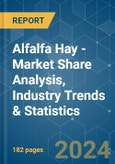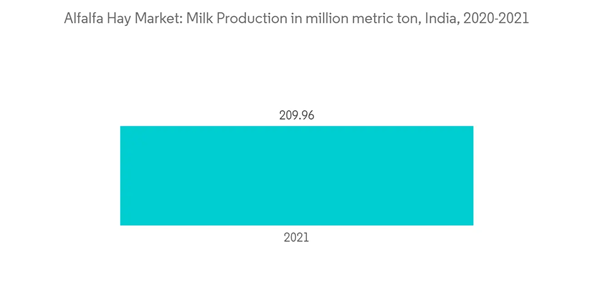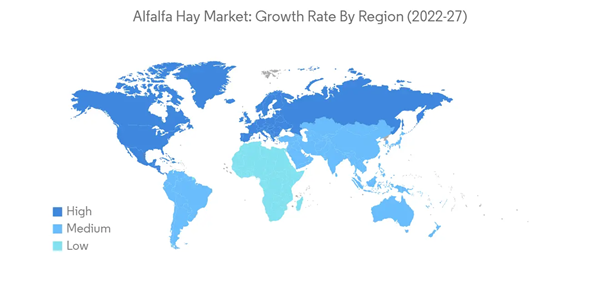The Alfalfa Hay Market size is estimated at USD 82.08 billion in 2024, and is expected to reach USD 113 billion by 2029, growing at a CAGR of 6.60% during the forecast period (2024-2029).
This product will be delivered within 2 business days.
Key Highlights
- Over the short term, the market is anticipated to achieve notable growth due to the increasing demand for quality hay for livestock and the cattle population. The use of alfalfa hay has become critical to animal feed due to its importance for crude protein content. Alfalfa hay enhances the growth and development of animals at a faster rate and improves milk productivity. Thus, dependence on alfalfa hay for animal feed may continue to drive the market over the forecast period.
- The increasing demand for dairy and animal products, shrinking land for grazing animals, growth in high-yielding cattle, and demand for cattle feed are driving the alfalfa hay market globally.
- North America is projected to be the largest market for alfalfa hay. China, Japan, the United Arab Emirates, and Saudi Arabia are significant importers of alfalfa hay from the United States. The United States and Spain are major exporters of alfalfa hay globally. Recently, alfalfa hay became critical to poultry feed, followed by animal feed, due to its importance for crude protein content.
- In 2021, the Indian Ministry of Commerce and Industry announced that India and the United States agreed to a framework to implement market access for agricultural products from both countries. India agreed to remove the heat treatment requirement for the US-origin alfalfa hay and recognize the current US pest mitigation methods for alfalfa hay. The Indian government also clarified that importing US alfalfa hay for animal feed will not require a non-genetically modified certificate.
Alfalfa Hay Market Trends
Increasing Demand for Dairy and Meat Products
- Livestock is a significant factor responsible for the growth of the alfalfa hay market. The annual growth of meat production and milk production in developing countries is projected to be 2.4% and 2.5%, respectively, by 2030. This factor is expected to increase the share of the developing countries in the world's meat production to 66.0%, i.e., 247.0 million metric tons, and 55.0% for milk production, i.e., 484.0 million metric tons. Furthermore, there has been immense pressure on the livestock sector to meet the increasing demand for high-value animal protein.
- India is the world's largest milk producer, contributing 23% of global milk production with around 70 million small-scale producers. There has been a growing demand for milk and milk-based products in the country. For instance, in 2021, about 83.0 million metric tons of fluid milk was consumed locally compared to 77.0 million metric tons in 2018.
- Dependence on alfalfa hay for animal feed may continue to drive the market over the forecast period. The demand for alfalfa hay is increasing significantly in China due to changing production practices in the Chinese dairy industry. This change is due to the increasing number of cows raised by modern dairy farmers who prefer using imported hay and commercial feeds.
- For instance, by 2020, the cattle population in China increased from 48.8 million heads to 51.0 million heads, according to the Food and Agriculture Organization. Furthermore, the Chinese government is focusing on boosting the domestic production of alfalfa hay to meet its high demand.
- A continual increase in the number of cattle through 2017-2021 and increasing demand for quality animal feed are expected to boost the demand for alfalfa hay over the forecast period.
North America Dominates the Market
- As of 2021, some of the alfalfa hay-producing states in the United States are Texas, Kansas, California, and Missouri. These states account for the majority of the alfalfa hay production in the country. China, Japan, Korea, Taipei, Saudi Arabia, and the United Arab Emirates are the top export destinations to the United States. China is expected to remain the key market for US alfalfa hay exports.
- In addition to the production, domestic dairy consumption has been rising over the years due to increasing non-fluid dairy sales. United States Department of Agriculture (USDA) data shows that American dairy consumption is continuing its growth trajectory. Since 1975, per capita consumption has grown by 22%. Further, dairy is anticipated to continue to grow as a category in the future, with a greater focus on producing sustainable food production.
- In the United States, alfalfa hay is the most important hay crop fed to dairy cattle. Dairy utilization accounts for two-thirds of the total alfalfa usage in the major dairy-producing states, such as California, Wisconsin, New York, Idaho, and New Mexico. Although dairy production is an important market for alfalfa hay, beef producers utilize alfalfa as a part of forage needs depending on availability and price.
- Further, alfalfa hay is Canada's most predominant legume grown for forage. It is grown almost 30% of Canada's cropland, and Ontario accounts for 22%. Alberta and Ontario are the major alfalfa hay-producing states in Canada. Hence, increased demand for alfalfa in domestic and export markets is anticipated to result in significant growth over the forecast period.
Alfalfa Hay Industry Overview
The alfalfa hay market is highly fragmented, with the presence of key players like Al Dahra ACX Global Inc., Standlee Hay Company, Alfalfa Monegros, Anderson Hay and Grain Co Inc, and Border Valley. These companies were involved in various strategic activities such as partnerships, expanding their presence, and mergers and acquisitions to strengthen their presence in the market.Additional Benefits:
- The market estimate (ME) sheet in Excel format
- 3 months of analyst support
This product will be delivered within 2 business days.
Table of Contents
1 INTRODUCTION
4 MARKET DYNAMICS
5 MARKET SEGMENTATION
6 COMPETITIVE LANDSCAPE
Companies Mentioned (Partial List)
A selection of companies mentioned in this report includes, but is not limited to:
- Al Dahra ACX Global Inc.
- Alfalfa Monegros SL
- Anderson Hay & Grain Inc.
- Bailey Farms
- Border Valley
- Coaba
- Cubeit Hay Company
- Glenvar Hay
- Green Prairie International
- Grupo Osés
- Gruppo Carli
- Hay USA
- Haykingdom Inc.
- Knight AG Sourcing
- Los Venteros SC
- M&C Hay
- McCracken Hay Company
- Riverina (Australia) Pty Ltd
- SL Follen Company
- Standlee Hay Company
Methodology

LOADING...










